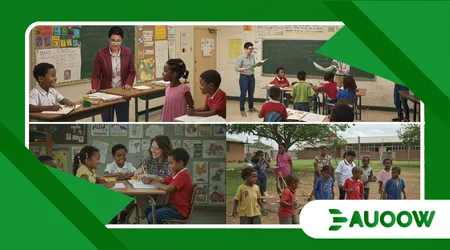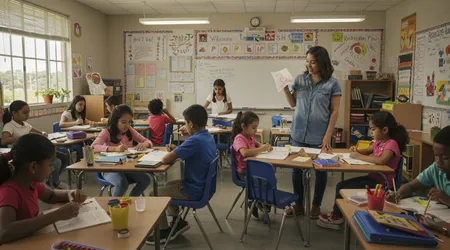Inclusive Education in Low-Income Communities: Barriers and Solutions

Inclusive education in low-income communities stands as a beacon of hope, yet it faces daunting challenges that demand creative, urgent solutions.
Imagine a classroom where every child, regardless of background or ability, thrives sounds idealistic, doesn’t it?
But in underserved areas, this vision often collides with harsh realities: underfunded schools, untrained teachers, and systemic inequities.
These barriers don’t just limit learning; they shape futures, perpetuating cycles of poverty.
This article dives into the obstacles blocking inclusive education in these communities and offers actionable solutions, grounded in real-world examples and data.
Why should every child have a fair shot at learning? Let’s explore how we can make that happen.
The journey to inclusive education is not just about opening classroom doors but ensuring every child feels seen, supported, and empowered.
In low-income communities, this mission is critical yet fraught with complexities.
From crumbling infrastructure to cultural stigmas, the challenges are multifaceted, but so are the opportunities for change.
By blending innovative strategies, community involvement, and policy reform, we can transform education into a tool for equity. Let’s unpack the barriers and solutions with a focus on real, impactful change.
Understanding the Barriers to Inclusive Education
Poverty creates a web of obstacles for inclusive education in low-income communities.
Limited funding often means schools lack basic resources like textbooks or desks. Many children arrive hungry, unable to focus on learning.
A 2023 UNESCO report found that 60% of low-income schools globally lack adequate infrastructure, directly impacting disabled students’ access.
Beyond physical limitations, teacher training is often insufficient. Educators may not know how to support students with disabilities or diverse needs.
In rural areas, schools may have one teacher for multiple grades, stretching resources thin. This gap undermines the inclusivity that education promises.
Cultural stigmas also block progress. In some communities, disabilities are misunderstood, leading to exclusion or low expectations.
Parents may prioritize work over school for their children, seeing education as a luxury. These attitudes entrench barriers, making inclusion feel like an uphill battle.
++ The Role of Parents in Shaping Inclusive Learning Environments
Transportation is another hurdle. Children in remote areas may walk miles to school, deterring attendance, especially for those with mobility issues. Without reliable transport, access to education remains a privilege, not a right.
Finally, systemic inequities exacerbate the problem. Policies often fail to prioritize marginalized groups, leaving gaps in funding and support.
Without targeted interventions, inclusive education in low-income communities remains a distant goal.

Innovative Solutions for Inclusive Education
Solutions for inclusive education in low-income communities start with creative resource allocation.
Mobile classrooms, like those used in Kenya’s rural areas, bring education to remote students. These buses, equipped with books and tablets, reduce transportation barriers.
Teacher training must evolve. Programs like Teach For All offer workshops on inclusive pedagogies, empowering educators to adapt lessons for diverse learners. Such training can transform classrooms into welcoming spaces.
Community engagement is key. In Brazil, local NGOs partner with schools to provide free meals, boosting attendance. These partnerships show how community-driven solutions can address basic needs, enabling learning.
Also read: How to Adapt Physical Education for Mixed-Ability Classes
Technology offers promise. Low-cost tablets with preloaded educational apps can bridge resource gaps. In India, initiatives like Pratham’s digital classrooms have reached thousands, proving tech’s potential.
Policy reform is critical. Governments must prioritize funding for inclusive infrastructure, like ramps and braille materials. Advocacy campaigns can pressure lawmakers to act, ensuring systemic change.
Empowering Communities Through Education
Engaging families is vital for inclusive education in low-income communities. Workshops that educate parents about disabilities reduce stigma.
In Uganda, community dialogues have increased enrollment of disabled children by 20%.
Local leaders can drive change. In South Africa, village chiefs advocate for school attendance, shifting cultural norms. Their influence helps prioritize education over child labor.
Peer support programs work wonders. Pairing students with mentors, like in Chicago’s after-school initiatives, fosters inclusion. These programs build confidence and reduce dropout rates.
Read more: Are Digital Learning Platforms Built with Inclusion in Mind?
Economic incentives also help. Conditional cash transfers, like Mexico’s Prospera program, reward families for keeping kids in school. This approach directly tackles poverty’s impact.
Finally, storytelling can inspire. Local radio campaigns sharing success stories of inclusive education motivate communities. These narratives humanize the cause, driving collective action.
Leveraging Technology for Accessibility
Technology can revolutionize inclusive education in low-income communities. Open-source platforms like Kolibri deliver offline learning to remote areas. These tools ensure access despite connectivity issues.
Assistive devices, such as low-cost braille displays, empower disabled students. In Ghana, schools using these tools report higher engagement among visually impaired learners.
Virtual training for teachers is scalable. Online modules on inclusive teaching, like those from UNESCO, reach educators in isolated regions, enhancing skills without travel.
Mobile apps can gamify learning. In Nigeria, apps like ULesson make lessons interactive, keeping students engaged. This approach boosts retention in under-resourced schools.
Data analytics can guide interventions. Tools tracking attendance and performance help schools allocate resources effectively, ensuring no child is left behind.
Policy and Advocacy for Systemic Change
Governments must prioritize inclusive education in low-income communities through targeted policies.
Allocating budgets for accessible infrastructure, like ramps, is a start. South Africa’s 2024 education budget increased funding for such upgrades by 15%.
Advocacy groups play a crucial role. Organizations like Human Rights Watch push for inclusive policies, holding governments accountable. Their campaigns amplify marginalized voices.
International partnerships can fill gaps. UNICEF’s collaboration with local governments in Ethiopia has built inclusive schools, serving thousands of disabled students.
Legislation must enforce accountability. Laws mandating teacher training on inclusion, like those in Brazil, ensure systemic progress. Compliance drives results.
Public awareness campaigns shift perceptions. Billboards and social media highlighting inclusive education in low-income communities can change attitudes, fostering broader support.
Measuring Success: A Data-Driven Approach
Tracking progress in inclusive education in low-income communities requires clear metrics. Enrollment rates, attendance, and graduation data reveal gaps and successes.
A 2024 UNICEF study showed a 10% rise in disabled student enrollment in targeted programs.
| Metric | Baseline (2020) | Progress (2024) |
|---|---|---|
| Disabled Student Enrollment | 45% | 55% |
| Teacher Training Completion | 30% | 50% |
| Accessible Classrooms | 20% | 35% |
Retention rates matter. Programs like India’s midday meal scheme increased attendance by 12%, showing how basic needs impact education.
Qualitative feedback is equally vital. Surveys from parents and students highlight cultural shifts, like reduced stigma around disabilities.
Technology can streamline data collection. Mobile apps tracking student progress help educators adjust strategies, ensuring inclusivity.
Regular audits ensure accountability. Governments and NGOs must review programs annually to sustain momentum and address gaps.
Real-World Examples of Impact

Consider Maria, a visually impaired girl in rural Guatemala. Her school, equipped with braille books via an NGO, enabled her to excel in math. This shows how targeted resources transform lives.
In Bangladesh, a mobile classroom program reaches 500 children monthly.
These buses, stocked with learning materials, bring inclusive education in low-income communities to life.
Another example: a South African school trained teachers in sign language. Deaf students, once isolated, now thrive, showing the power of skilled educators.
In India, a community-led tutoring program pairs volunteers with struggling students. This initiative has boosted literacy rates by 8% in two years.
These stories highlight a truth: small, intentional changes can ripple outward, reshaping entire communities through education.
A Call to Action: Building a Collective Future
The path to inclusive education in low-income communities is steep but not insurmountable. It demands collaboration governments, NGOs, communities, and educators must unite.
Every step forward, from a new ramp to a trained teacher, builds a fairer world.
This isn’t just about schools; it’s about dignity. Education is the key to breaking poverty’s grip, offering every child a chance to dream. Will we rise to the challenge?
The solutions are within reach. Fund accessible infrastructure, train teachers, engage communities, and leverage technology. These steps, grounded in real success, can redefine futures.
Let’s commit to action. Advocate for policies, support local initiatives, and amplify marginalized voices. Together, we can make inclusive education a reality for all.
Frequently Asked Questions
What is inclusive education in low-income communities?
It’s education ensuring all children, regardless of ability or background, access quality learning in under-resourced areas, addressing barriers like poverty and stigma.
Why is inclusive education harder in low-income areas?
Limited funding, untrained teachers, cultural stigmas, and poor infrastructure create significant obstacles, often exacerbated by systemic inequities and lack of resources.
How can technology help?
Low-cost tablets, offline platforms, and assistive devices like braille displays enhance access and engagement, making learning inclusive despite resource constraints.
What role do communities play?
Communities reduce stigma through education, advocate for attendance, and provide support like meals, creating a foundation for inclusive education to thrive.
How can I support inclusive education?
Donate to NGOs, advocate for policy changes, or volunteer locally. Supporting teacher training or infrastructure projects directly impacts low-income communities.
References:
- UNESCO. (2023). Global Education Monitoring Report.
- UNICEF. (2024). Inclusive Education Progress Report.
- Human Rights Watch. (2024). Advocacy for Inclusive Education.
